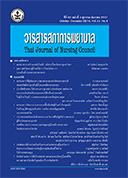Effects of Epilepsy on Children: Prevention and Treatment
Keywords:
epilepsy in children, intellectual disability, attention defcit, depressiveAbstract
Epilepsy is a chronic neurological disease with several physical, psychological,
emotional, social, and intellectual impacts on children. Epilepsy is caused by two
major kinds of factors: epilepsy-related factors and treatment-related factors.
Epilepsy-related factors include brain dysfunction, epilepsy symptoms, and frequency
and severity of each seizure. Treatment-related factors include prolonged use of
antiepileptic drugs or improper care, for example, irregular intake of antiepileptic
drugs, which could result in an uncontrollable seizure, and improper seizure
management.
Without proper care or treatment, epilepsy could have adverse effects on epileptic
children’s quality of life. Nurses, therefore, play an important part in preventing or
alleviating such impacts of epilepsy on children, as well as in providing caregivers with
advice, to enhance their capacity to take care of epileptic children. In addition, nurses
should possess accurate knowledge and understanding of epilepsy and its effects on
children. In response to such needs, this article presents important facts about epilepsy,
its common effects on children, factors related to its effects, and roles of nurses in
preventing epilepsy in children and caring for epilepsy-affected children.
Downloads
References
1. Camfeld P, Camfeld C. Incidence, prevalence and aetiology of seizures and epilepsy in children.
Epileptic Disord 2015; 17(2): 117-23.
2. Asawavichienjinda T, Sitthi-Amorn C, Tanyanont W. Prevalence of epilepsy in rural Thailand: a population-based study. J Med Assoc Thai 2002; 85(10): 1066-73.
3. Aaberg KM, Bakken IJ, Lossius MI, Lund Soraas C, Haberg SE, Stoltenberg C, Suren P, Chin R. Comorbidity and childhood epilepsy: a nationwide registry study. Pediatrics 2016; 38(3): 1-10.
4. Fisher RS, Acevedo C, Arzimanoglou A, Bogacz A, CrossH,ElgerCE,etal.Apracticalclinical defnition of epilepsy. Epilepsia 2014; 55(4): 475-82.
5.Al-Qudah AA, Albsoul-Younes A, Masri AT, Aburahmah SK, Alabadi IA, Naf OA, et al. Type and etiology of pediatric epilepsy in Jordan. a multi-center study. Neurosciences 2017; 22(4):267-73.17
6. Scheffer IE, Berkovic S, Capovilla G, Connolly MB,French J, Guilhoto L, et al. ILAE classifcation of theepilepsies:positionpaperoftheILAEcommission for classifcation and terminology. Epilepsia 2017; 58(4): 512-21.
7. Falco-walter JJ, Scheffer IE, Fisher RS. The new defnition and classifcation of seizures and epilepsy. Epilepsy Res 2018; 139: 73-9.
8. Prasat Neurological Institute. Clinical practice guidelines for epilepsy. Bangkok: Tanapress CO., LTD; 2016. (in Thai)
9.Visudtiban A. Textbook of epilepsy. Bangkok: holistic publishing CO., LTD; 2011. (in Thai)
10.Pellock JM, Nordli Jr DR, Sankar R, Wheless JW, editors. Pellock’s pediatric epilepsy: diagnosis and therapy. United States of America: SCI; 2017.
11. Boonyapisit K. Idiopathic epilepsy syndromes. In: Bhidayasiri R, Pulkes T, Muengtaweepongsa S,editors. Textbook of clinical neurology volume 1.Bangkok: The neurological society of Thailand;2013. p. 220-26. (in Thai)
12.Nickels KC, Wong-Kisiel LC, Moseley BD, Wirrell EC. Temporal lobe epilepsy in children. Epilepsy Res Treat 2012: 1-16.
13.Dang LT, Silverstein FS. Drug treatment of seizure and epilepsy in newborns and children. Pediatr Clin N Am 2017; 64: 1291-1308.
14.Rosati A, De masi S, Guerrini R. Antiepileptic drug treatment in children with epilepsy. CNS Drugs 2015; 29: 847-63.
15.KossoffEH,HaneyCA.Ketogenicdiets.In: Shorvon S, Perucca E, Engel Jr J, editors. The treatment of epilepsy. Singapore: Markono Print Media; 2016. p. 288-97.
16.ChomtoK.Continumm:non-pharmacological, nonsurgical treatment for epilepsy. Epilepsy digest 2009: 4-5. (in Thai)
17.Wei SH, Lee WT. Comorbidity of childhood epilepsy. Journal of the Formosan Medical Association 2015; 114: 1031 38.
18.St. Louis EK, Ficker DM, O’Brien TJ, editors. Epilepsy and the interictal state: co-morbidities and quality of life. India: Laserwords Private Limited; 2015.
19.Bujoreanu IS, Ibeziako P, Demaso DR. Psychiatric concerns in pediatric epilepsy. Child Adoles Psychiatric Clin N Am 2010; 19: 371-86.
20. Parbparl K. Treatment of epilepsy in common special situations. Bangkok: Sahamitpattana Printing; 2014.
(in Thai)
21. Boonyasidhi V. Attention defcit hyperactivity disorder: diagnosis and management. J Psychiatr
Assoc Thailand 2012; 57(4): 373-86. (in Thai)
22.Vidaurre J, Twanow J D E. Attention defcit hyperactivity disorder and associated cognitive dysfunction in pediatric epilepsy. Semin Pediatr Neurol 2017; 24: 282-91.
23.Verrotti A, Moavero R, Panzarino G, Di Paolantonio C, Rizzo R, Curatolo P. The challenge of pharmacotherapy in children and adolescents with epilepsy-ADHD comorbidity. Clin Drug Investig 2018; 38(1): 1-8.
24.Arunpongpaisal S, Vasiknanonte S, editors. Textbook of depressive disorders. Khonkaen:Klungnanavitthata Press; 2015. (in Thai)
25.Guilfoyle SM, Monahan S, Wesolowski C, Modi AC. Depression screening in pediatric epilepsy: evidence for the beneft of a behavioral medicine service in early detection.Epilepsy Behav 2015; 44:5-10.18
26.Sidtirak N, Wannasewok K, Wannarit K, Pukrittayakamee P, Apinuntavech S, Katumarn P, editors. Psychiatry Siriraj DSM-5. Bangkok:Prayoonsanthai Press; 2015. (in Thai)
27.Puka K, Widjaja E, Smith ML. The influence of patient caregiver, and family on symptoms of anxiety and depression in children and adolescents with intractable epilepsy. Epilepsy Behav 2017; 67: 45-50.
28.Buelow JM, Shore CP. Management challenges in children with both epilepsy and intellectual disability.
Clin Nurse Spec 2010; 24(6): 313-20.
29.Kwong KL, Lam D, Tsui S, Ngan M, Tsang B, Lam S. Attention defcit hyperactivity disorder in adolescents with epilepsy. Pediatr Neurol 2016; 57:56-63.
30.Salpekar JA, Mishra G, Hauptman AJ. Key issues in addressing the comorbidity of depression and pediatric epilepsy. Epilepsy Behav. 2015; 46: 12-8.








